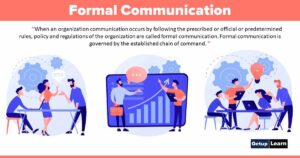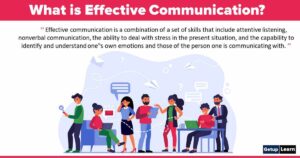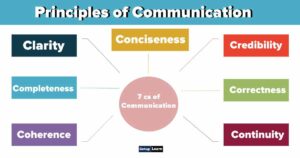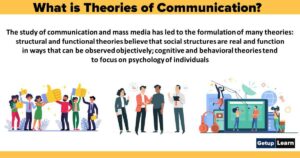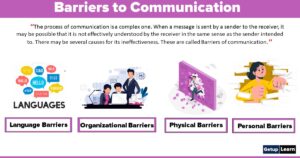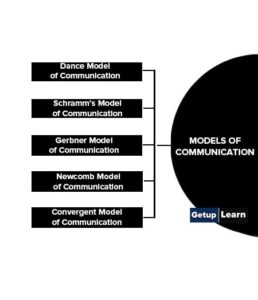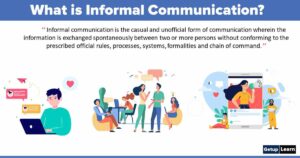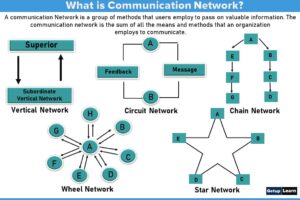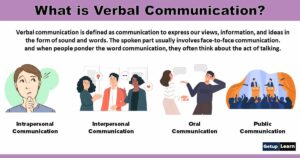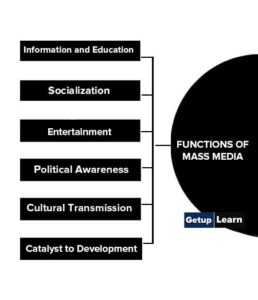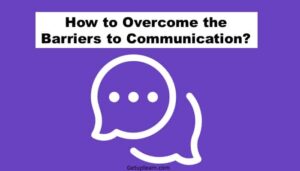Table of Contents
- 1 What is Nonverbal Communication?
- 2 Definition of Nonverbal Communication
- 3 Advantages of Non Verbal Communication
- 4 Disadvantages of Non Verbal Communication
- 5 Functions of Nonverbal Communication
- 6 Types of Nonverbal Communication
- 7 How to Improve Non Verbal Communication Skills
- 8 Principles of Nonverbal Communication
- 9 FAQ Related to Nonverbal Communication
What is Nonverbal Communication?
Nonverbal Communication refers to communication that is produced by some means other than words (eye contact, body language, or vocal cues. In other words, communication without using words, such as gestures, body language, the facial expressions is called non-verbal communication.

Table of Contents
For example:
-
Expression of Emotion: Emotions are expressed mainly through the face, body, and voice.
-
Communication of Interpersonal Attitudes: The establishment and maintenance of relationships if often done through nonverbal signals (tone of voice, gaze, touch, etc.).
-
Accompany and Support Speech: Vocalization and nonverbal behaviors are synchronized with a speech in conversation (nodding one’s head or using phrases like “uh-huh” when another is talking).
-
Self-Presentation: Presenting oneself to another through nonverbal attributes like appearance.
- Rituals: The use of greetings, handshakes, or other rituals.
Definition of Nonverbal Communication
These are the definitions of nonverbal communication given below:
[su_quote cite=”Charles Darwin“]The power of communication between the members of the same tribe by means of language has been of paramount importance in the development of man, and the course of language is much aided by the expressive movements of the face and the body.[/su_quote]
[su_quote cite=”Author”]Definition[/su_quote]
[su_quote cite=”Author”]Definition[/su_quote]
Advantages of Non Verbal Communication
These are the advantages of non verbal communication:
- Easy Presentation
- Substituting
- Help to Illiterate People
- Help to Handicapped People
- Attractive Presentation
- Quick Expression of Message
- Reducing Wastage of Time

Easy Presentation
Easy presentation: Information can be easily presented in non-verbal communication by using visual, audio-visual, and silent means of non-verbal communication.
Substituting
Substituting: Non-verbal message may substitute for the verbal message especially if it is blocked by noise, interruption, long distance, etc. for example; gestures-finger to lips to indicate the need for quiet, facial expressions- a nod instead of a yes.
Help to Illiterate People
Help illiterate people: This type of communication uses gestures, facial expressions, eye contact, proximity, touching, etc., and without using any spoken or written word. So, it is very much helpful for illiterate people.
Help to Handicapped People
Help to handicapped people: Non-verbal cues of communication greatly help handicapped people, especially deaf people. Deaf people exchange messages through the movements of hands, fingers, eyeballs, etc.
Attractive Presentation
Attractive presentation: Non-verbal communication is based on visuals, pictures, graphs, signs etc. that can be seen as very much attractive.
Quick Expression of Message
Quick expression of the message: Non-verbal cues of communication like signs and symbols can also communicate some messages very quickly than written or oral messages.
Reducing Wastage of Time
Reducing wastage of time: The message of non-verbal communication reached the receiver very fast. For this reason, it reduces the wastage of valuable time of the communicator.
Disadvantages of Non Verbal Communication
These are the disadvantages of non verbal communication:
- Vague and Imprecise
- Long Conversations Are Not Possible
- Difficult to Understand
- Costly
- Distortion of Information
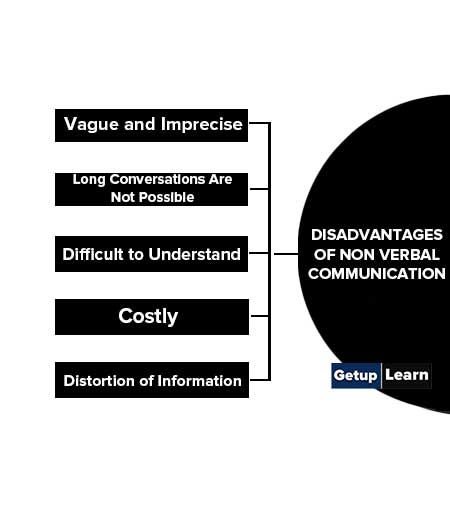
Vague and Imprecise
Vague and imprecise: Non-verbal communication is quite vague and imprecise. In this communication, there is no use of words or language which expresses clear meaning to the receiver.
Long Conversations Are Not Possible
Long conversations are not possible: In non-verbal communication, long conversation and necessary explanations are not possible. No party can discuss the particular issues of the messages.
Difficult to Understand
Difficult to understand and requires a lot of repetitions in non-verbal communication. Since it uses gestures, facial expressions eye contact, touch, etc. for communicating with others it may not be understandable for simple and foolish people.
Costly
Costly: In some cases, non-verbal communication involves huge costs. For example, neon signs, PowerPoint presentations, cinemas,s, etc are very much costly compared to other forms of communication.
Distortion of Information
Distortion of information: Since it uses gestures, facial expressions, eye contact, touch, sign, sound, paralanguage, etc. for communicating with others, there is a great possibility of distortion of information in non-verbal communication.
Functions of Nonverbal Communication
These are the following functions of nonverbal communication which are given below:
- Nonverbal Communication Conveys Meaning
- Nonverbal Communication Influences Others
- Nonverbal Communication Regulates Conversational Flow
- Nonverbal Communication Affects Relationships
- Nonverbal Communication Expresses Our Identities
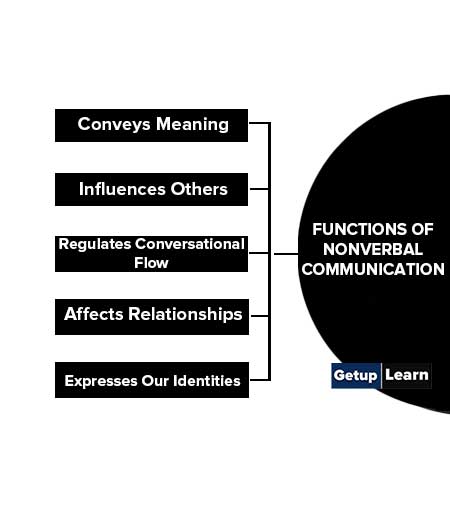
Nonverbal Communication Conveys Meaning
Nonverbal communication conveys meaning by reinforcing, substituting for, or contradicting verbal communication. As we’ve already learned, verbal and nonverbal communication are two parts of the same system that often work side by side, helping us generate meaning. In terms of reinforcing verbal communication, gestures can help describe a space or shape that another person is unfamiliar with in ways that words alone cannot.
Nonverbal Communication Influences Others
Nonverbal communication can be used to influence people in a variety of ways, but the most common way is through deception. Deception is typically thought of as the intentional act of altering information to influence another person, which means that it extends beyond lying to include concealing, omitting or exaggerating information.
Nonverbal Communication Regulates Conversational Flow
Nonverbal communication helps us regulate our conversations so we don’t end up constantly interrupting each other or waiting in awkward silences between speaker turns. Pitch, which is a part of vocalists, helps us cue others into our conversational intentions.
Nonverbal Communication Affects Relationships
To successfully relate to other people, we must possess some skill at encoding and decoding nonverbal communication. The nonverbal messages we send and receive influence our relationships in positive and negative ways and can work to bring people together or push them apart.
Nonverbal cues communicate intimacy and signal the connection between two people. These relational indicators can be objects such as wedding rings or tattoos that are symbolic of another person or the relationship, actions such as sharing the same drinking glass, or touch behaviors such as hand-holding.
Nonverbal Communication Expresses Our Identities
Nonverbal communication expresses who we are. Our identities (the groups to which we belong, our cultures, our hobbies, and interests, etc.) are conveyed nonverbally through the way we set up our living and working spaces, the clothes we wear, the way we carry ourselves, and the accents and tones of our voices.
Our physical bodies give others impressions about who we are, and some of these features are more under our control than others.
Types of Nonverbal Communication
These are the different types of nonverbal communication:
- Kinesics
- Facial Expressions
- Head Movements and Posture
- Gestures
- Eye Gaze
- Proxemics
- Appearance and Artifacts
- Paralinguistics
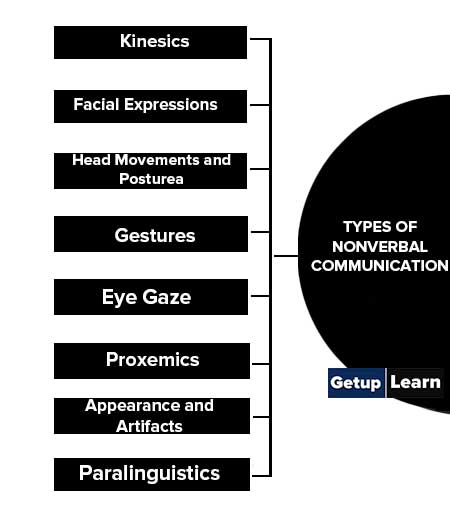
Kinesics
The word kinesics comes from the root word kinesis, which means “movement,” and refers to the study of hand, arm, body, and face movements. Specifically, this section will outline the use of gestures, head movements and posture, eye contact, and facial expressions as nonverbal communication.
Facial Expressions
Our faces are the most expressive part of our bodies. Think of how photos are often intended to capture a particular expression “in a flash” to preserve for later viewing. Even though a photo is a snapshot in time, we can still interpret much meaning from a human face caught in a moment of expression, and basic facial expressions are recognizable by humans all over the world. Like
For example happiness, sadness, fear, anger, and disgust.
Head Movements and Posture
Head movements and posture are often both used to acknowledge others and communicate interest or attentiveness. In terms of head movements, a head nod is a universal sign of acknowledgment in cultures where the formal bow is no longer used as a greeting.
In these cases, the head nod essentially serves as an abbreviated bow. An innate and universal head movement is the head shake back and forth to signal “no.” This nonverbal signal begins at birth, even before a baby has the ability to know that it has a corresponding meaning,
For example:
- A head-up typically indicates an engaged or neutral attitude
- A head tilt indicates interest and is an innate submission gesture that exposes the neck and subconsciously makes people feel more trusting of us.
- A head down signals a negative or aggressive attitude.
In posture there are four general human postures: standing, sitting, squatting, and lying down. Within each of these postures, there are many variations, and when combined with particular gestures or other nonverbal cues they can express many different meanings.
Most of our communication occurs while we are standing or sitting. One interesting standing posture involves putting our hands on our hips and is a nonverbal cue that we use subconsciously to make us look bigger and show assertiveness.
Gestures
There are three main types of gestures: adaptors, emblems, and illustrators.
Adaptors are touching behaviors and movements that indicate internal states typically related to arousal or anxiety. Adaptors can be targeted toward the self, objects, or others. In regular social situations, adaptors result from uneasiness, anxiety, or a general sense that we are not in control of our surroundings.
Emblems are gestures that have a specific agreed-on meaning. These are still different from the signs used by hearing-impaired people or others who communicate using American Sign Language (ASL). Even though they have a generally agreed-on meaning, they are not part of a formal sign system like ASL that is explicitly taught to a group of people.
A hitchhiker’s raised thumb, the “OK” sign with the thumb and index finger connected in a circle with the other three fingers sticking up, and the raised middle finger are all examples of emblems that have an agreed-on meaning or meanings with a culture.
Illustrators are the most common type of gesture and are used to illustrate the verbal message they accompany. For example, you might use hand gestures to indicate the size or shape of an object. Unlike emblems, illustrators do not typically have meaning on their own and are used more subconsciously than emblems.
Eye Gaze
Looking, staring, and blinking can also be important nonverbal behaviors. When people encounter people or things that they like, the rate of blinking increases, and pupils dilate. Looking at another person can indicate a range of emotions, including hostility, interest, and attraction.
Proxemics
Proxemics refers to the study of how space and distance influence communication. We only need to look at the ways in which space shows up in common metaphors to see that space, communication, and relationships are closely related. For example.
- When we are content with and attracted to someone, we say we are “close” to him or her.
- When we lose connection with someone, we may say he or she is “distant.”
In general, space influences how people communicate and behave. Smaller spaces with a higher density of people often lead to breaches of our personal space bubbles. If this is a setting in which this type of density is expected beforehand, like at a crowded concert or on a train during rush hour, then we make various communicative adjustments to manage the space issue.
Thus, there are different spaces depending on the relationship between the persons communicating. In general, there are four types of space people use while communicating.
- Public Space
- Social Space
- Personal Space
- Intimate Space
Appearance and Artifacts
Believing that others “do not judge a book by its cover” is a naive frame of thought. How one dresses and presents themselves proclaims a persona and creates a first impression.
For example, If a person is sloppily dressed some may assume their work is also sloppy. If one’s appearance is well kept and professional others might assume their work follows suit.
To be successful, one needs to look at the part and “appear corporate”; doing this will lead to a better first impression.
Paralinguistics
Paralinguistics refers to vocal communication that is separate from actual language. This includes factors such as tone of voice, loudness, inflection, and pitch. Consider the powerful effect that tone of voice can have on the meaning of a sentence. When said in a strong tone of voice, listeners might interpret approval and enthusiasm. The same words said in a hesitant tone of voice might convey disapproval and a lack of interest.
How to Improve Non Verbal Communication Skills
The following tips can help you learn to read the nonverbal signals of other people and enhance your own ability to communicate effectively. These are the steps to improve non verbal communication skills.
Pay Close Attention to Non Verbal Signals
- Avoid giving conflicting signals.
- Try to be as honest as possible in communicating your emotions.
- Smile genuinely. Faking a smile is obvious to the observer.
- Maintain the eye contact your audience expects.
- Be aware of your posture and of the gesture you use.
- Try to use appropriate vocal signals while minimizing unintentional messages.
- Imitate the appearance of the people you want to impress.
- Respect your audience’s comfort zone.
- Adopt a handshake that matches your personality and intention.
- Be aware of varying attitudes towards time.
- Use touch only when appropriate.
Interpret Nonverbal Signals Carefully
- Be aware that people may give false nonverbal cues.
- Remember, few gestures convey meaning in and of themselves.
Consider nonverbal signals in the context of situation and culture.
Principles of Nonverbal Communication
These are the principles of nonverbal communication:
Nonverbal Communication Conveys Important Interpersonal and Emotional Messages.
Nonverbal Communication Is More Involuntary than Verbal.
Nonverbal Communication Is More Ambiguous.
Nonverbal Communication Is More Credible.
Read More Related Articles
[su_spoiler title=”What is Communication? | Mass Communication” style=”fancy” icon=”plus-circle”]
What is Communication?
[/su_spoiler]
[su_spoiler title=”Types of Communication | Principles of Communication” style=”fancy” icon=”plus-circle”]
-
Types of Communication
- Verbal Communication
- Non-Verbal Communication
- Written Communication
- Visual Communication
- Feedback Communication
- Mass Communication
- Group Communication
[/su_spoiler]
[su_spoiler title=”Nonverbal Communication | Verbal Communication” style=”fancy” icon=”plus-circle”]
Nonverbal Communication
[/su_spoiler]
[su_spoiler title=”Written Communication | Oral Communication” style=”fancy” icon=”plus-circle”]
Written Communication
[/su_spoiler]
[su_spoiler title=”Business Communication | Organizational Communication” style=”fancy” icon=”plus-circle”]
[/su_spoiler]
[su_spoiler title=”Formal Communication | Informal Communication” style=”fancy” icon=”plus-circle”]
[/su_spoiler]
[su_spoiler title=”Interpersonal Communication | Informal Communication” style=”fancy” icon=”plus-circle”]
[/su_spoiler]
[su_spoiler title=”Downward Communication | Upward Communication” style=”fancy” icon=”plus-circle”]
[/su_spoiler]
[su_spoiler title=”Barriers to Communication | Horizontal or Lateral Communication” style=”fancy” icon=”plus-circle”]
[/su_spoiler]
[su_spoiler title=”Self Development | Effective Communication” style=”fancy” icon=”plus-circle”]
[/su_spoiler]
[su_spoiler title=”Difference Between Oral and Written Communication | Theories of Communication” style=”fancy” icon=”plus-circle”]
[/su_spoiler]
What are 5 examples of nonverbal communication?
Nonverbal Communication refers to communication that is produced by some means other than words (eye contact, body language, or vocal cues. In other words, communication without using words, such as gestures, body language, the facial expressions is called non-verbal communication.
What are the advantages of non-verbal communication?
These are some important Advantages of Non verbal Communication: 1. Easy Presentation, 2. Substituting, 3. Help to Illiterate People, 4. Help to Handicapped People, 5. Attractive Presentation, 6. Quick Expression of Message, 7. Reducing Wastage of Time etc.
What are the disadvantages of verbal communication?
These are some disadvantages of verbal communication: 1. Vague and Imprecise, 2. Long Conversations Are Not Possible, 3. Difficult to Understand, 4. Costly, 5. Distortion of Information etc.
What are the 5 functions of non verbal communication?
Following are 5 functions of non verbal communication: 1. Conveys Meaning, 2. Influences Others, 3. Regulates Conversational Flow, 4. Affects Relationships, 5. Expresses Our Identities etc.

